The purpose of this study was to investigate presence of employee engagement in Banglalink. Moreover, another motive is to find out the potential relationship between employee engagement and Organizational Citizenship Behavior (OCB) and turnover rate. The Culture of Banglalink is totally different from other organizations. There have been conducting many research related toEmployee engagement and OCB. But it is important to conduct studies across organizations to compare results in order to create sound knowledge, especially for relatively new concepts like employee engagement and OCB. Second, although employee engagement is a topic that has been increasingly examined from both academic and practical perspectives, its conceptual framework is still unclear. More specifically, organizational support and supervisor support is important since it relates to overall employee perceptions about how well an organization responds to their needs, which can impact the level of engagement.
Training and development opportunities related to both current tasks and future developmental preparation have received much attention, especially in terms of the amount each company invests in these activities and their estimated impact. Moreover, Reward is main reason to work for organization. Along with this Equal treatment and Justice creates a sense of equality among the employees thus helps to create OCB. So the clear purpose is to find out the possible relationship between each of the variables of Employee Engagement with building OCB among the employees of Banglalink.
Methodology
Primary data- I have collected all the primary data to conduct the survey and interview.
Secondary data- On the other hand, the secondary sources which refer the published journals, articles, internet, and books and so on are used by me for extra information which has enhanced my knowledge on the topic.
Overview of Banglalink Digital Communication Ltd.
Banglalink Digital Communications Ltd. is a public limited company which has been registered under the Companies Act 1994. It is the 2nd Growth over the last years have been fuelled with innovative products and services targeting
different market segments, aggressive improvement of network quality and dedicated customer care, creating an extensive distribution network across the country, and establishing a strong brand that emotionally connected customers with Banglalink.
The success of Banglalink is based on a simple mission: “Bringing mobile telephony to the masses” which was the cornerstone of its strategy. Banglalink has changed the mobile phone status from luxury to a necessity and brought mobile telephone to the general people of Bangladesh and made a place in their hearts. The mobile phone has become the symbol for the positive change in Bangladesh.
Banglalink attained 1 million subscribers by December 2005 and 3 million subscribers in October 2006. In less than two years which is by December 2007, Banglalink overtook ‘Sheba’ (currently known as Banglalink) to become the second largest operator in Bangladesh with more than 7.1 million customers. The company currently has recently attained 20 million subscribers as of January 2011, representing a market share of 28.2% as of February 2011.
Organizational Structure of Banglalink
Banglalink has top, middle and first level management. It has seven major departments such as Finance & Accounts, Sales, Marketing, IT, Administration, Customer Care and Human Resource. The total numbers of employees are around 2700.

HR Operations and Its Activities
HR Operations refer to the day-to-day operations essential to meeting the needs of employees in the organization. So HR operations are about how you manage day-today issues and comply with the legal requirements of employing people. It covers the thinking, structure and processes behind the people issues that determine an organization’s
success.
In HR operations HR staffs are performed as core level administrators. The tasks they accomplish are generally highly visible to other employees because they are focused on the daily work issues attributed to the ongoing needs of an organization. These include vital tasks such as interviewing and hiring, employee joining, implementing organizational policies, maintaining employment law, resignation of employees with proper final settlement, compensation and benefit issues. In HR Operations management may use and maintain computerized HR information systems.
Key HR Operations performing in Banglalink
In Banglalink the HR operations team is mainly responsible for post selection activities, because the recruitment team is dealing with pre selection activities as well as hiring employees. So the key tasks that HR Operations team performing in Banglalink are given bellow:
On Boarding Formalities:
After successfully passing the medical test recruitment team provides him/her the joining bunch and informs to come for joining on a specific date. Similarly, recruitment team also informs the HR Operation team to conduct the joining procedure. The joining bunch includes letter of joining, employee particulars form, and application for employee identification card, pool phone requisition form, declaration form, bank account information, post-employment reference check and acknowledgement of the code of conduct.
Employee Engagement Activities and Its Outcome
Employees’ willingness and ability to help their company succeed, largely by providing discretionary effort on a sustainable basis is called Employee Engagement.” by Perrin’s Global Workforce Study (2003) uses the definition According to the study, engagement is affected by many factors which involve both emotional and rational factors relating to work and the overall work experience.
Gallup organization defines employee engagement as the involvement with and enthusiasm for work. Robinson et al. (2004) define employee engagement as “a positive attitude held by the employee towards the organization and its value. An engaged employee is aware of business context, and works with colleagues to improve performance within the job for the benefit of the organization. The organization must work to develop and nurture engagement, which requires a two-way relationship between employer and employee.”
This verdict and definition forwarded by Institute of Employment Studies gives a clear insight that employee engagement is the result of two-way relationship between employer and employee pointing out that there are things to be done by both sides.
A satisfied employee is one who is happy with his/her company, role and co-workers etc. An engaged employee is one who gives additional discretionary effort; goes beyond their job description. Further, the most worthwhile engagement is seen in employees who happily want to give additional effort and know where to apply it. This combination of action and line of sight results in an engaged employee who willingly works harder to deliver against your company’s strategic objectives in their own daily tasks.
The concept itself is not new; the mixes of factors that make up employee engagement have been around for a long time. The distinctive feature of employee engagement as an idea is that it pulls all of the positive job and work attitudes together under one umbrella. One definition of engagement show’s it having three main compartments from the employee:

- Emotional Attachment – to the organization, their job and their work
- Rational Understanding – of organization’s goals, values and how they contribute
- Motivation and Willingness – Invest discretionary effort to perform better
It is common sense that now more than ever that leaders need to ensure they foster engagement more than ever.
Importance of Employee Engagement
Employee engagement helps develop strong positive attitudes among people towards their work and their organization which plays a major role in ensuring that they give their best even when times are tough. It is important as because
• Employees truly engaged in the business.
• Full and honest understanding of how the workforce feels about the CEO, senior management team, their line manager & colleagues.
• A sustainable culture of employee engagement. Emotional Rational Motivational Engagement
• Improved trust between your employees and senior management team.
• Employees that believe in the product/service they are offering.
• It is a means to an end- the end goal being organizational effectiveness;

It is important to have engaged employment. After conducting the survey I found.
- 65% of the total respondents are thinking that it is very important for Banglalink to address employee engagement.
- 24% of the total respondents are thinking that it is important for Banglalink to address employee engagement.
- Another 13% of the total respondents are thinking that it is very important for Banglalink to address employee engagement.
- Rests of the respondent are thinking that it is not important for Banglalink to address employee engagement.
Factors Foster Employee Engagement
There are three factors which foster Employee engagement.
• Achievement: The vast majority of employees want to achieve something important and meaningful at work. They want to grow and develop their skills and capabilities and they want to be rewarded and recognized for their efforts.
• Camaraderie: Employees enjoy working productively with others while developing healthy interpersonal relationships. How managers interact with their teams is especially important in motivating employees to go above and beyond.
• Equity: Employees want to be treated fairly when it comes to pay and benefits, day to day treatment and psychological and physical safety. When these three needs are met, employees are highly engaged and even enthusiastic at work.
The Engagement Effort at Banglalink:
The verb ‘to engage’ has the variety of meaning, ranging from straightforward and transactional (to hire someone to do the job), to exciting and mysterious. Arranging these meanings in order, depending on the likely effort involved implies that Banglalink has a choice when it comes to engaging employees. They can choose the type of engagement they would like to offer and the extent to which they go beyond the merely transactional- that is how much effort they make go towards the right hand side of the diagram.
Employees, too have a choice. They can choose, in the first place, whether or not to be attracted into the organization – and, having arrived, they can decide whether or not their job continues to interest them sufficiently to stay in it and develop it. Some employees rarely move beyond a transactional relationship, but many require something more from their jobs-a sense of self worth and being valued and an opportunity to succeed and progress. Those aspects of a job that engage a particular employee may vary over his or her working lifetime in the line with changing circumstances and interest.

Employee Engagement Strategies of Banglalink:
So far we have discussed the evolution and definition of employee engagement, the factors that affect it and importance of employee engagement explaining how it is linked to business performance. Now, at this stage any inquisitive reader may ask a question: So what? Employee engagement strategies listed below answer this question. In order to have engaged employees in any organization, managers need to look at the following ten points. We can call these points “tablets” because it is believed that they will cure employee disengagement diseases. Take these ten tablets:
Start it on day one: Banglalink has clear new talent acquisition strategies. Effective recruitment and orientation programs are the first building blocks to be laid on the first day of the new employee. Managers are very careful in pooling out the potential talent of the new employee through effective recruitment. The newly hired employee are given both general orientation which is related to the company mission, vision, values, policies and procedures and job-specific orientation such as his/her job duties, and responsibilities, goals and current priorities of the department to which the employee belongs in order to enable him/her to develop realistic job expectations and reduce role conflict that might arise in the future. A manager has to ensure roletalent fit when placing an employee in a certain position and exert all managerial efforts needed to retain that talent in the organization.
Start it from the top: Employee engagement requires leadership commitment through establishing clear mission, vision and values. Unless the people at the top believe in it, own it, pass it down to managers and employees, and enhance their leadership, employee engagement will never be more than just a “corporate fad” or “another HR thing”. Employee engagement does not need lip-service rather dedicated heart and action-oriented service from top
management. It requires “Leading by Being example”.
Enhance employee engagement through two-way communication: Managers of Banglalink promote two-way communication. Employees are not sets of pots to which managers pour out their ideas without giving them a chance to have a say on issues that matter to their job and life. Clear and consistent communication of what is expected of them paves the way for engaged workforce. Managers involve their people and always show respect to their input. Along with this, Manager shares power with their employees through participative decision making so
that they would feel sense of belongingness thereby increasing their engagement in realizing it.
Give satisfactory opportunities for development and advancement: Banglalink encourages independent thinking through giving them more job autonomy so that employees will have a chance to make their own freedom of choosing their own best way of doing their job so long as they are producing the expected result. Manage through results rather than trying to manage all the processes by which that result is achieved.
Ensure that employees have everything they need to do their jobs: Managers are expected to make sure that employees have all the resources such as physical or material, financial and information resources in order to effectively do their job.
Give employee’s appropriate training: Banglalink helps employees to update themselves increasing their knowledge and skills through giving appropriate trainings. Generally it is understood that when employees get to know more about their job, their confidence increases there by being able to work without much supervision from their immediate managers which in turn builds their self-efficacy and commitment.
Have strong feedback system: Banglalink has developed a performance management system which holds managers and employees accountable for the level of engagement they have shown. Conducting regular survey of employee engagement level helps make out factors that make employees engaged. After finalizing the survey, it is advisable to determine all the factors that driving engagement in the organization, then narrow down the list of factors to focus on two or three areas. It is important that organizations begin with a concentration on the factors that will make the most difference to the employees and put energy around improving these areas as it may be difficult to address all factors at once. Managers are behind such survey results and develop action-oriented plans that are specific, measurable, and accountable and time- bound.
Incentives have a part to play: Managers are working out both financial and nonfinancial benefits for employees who show more engagement in their jobs. Several management theories have indicated that when employees get more pay, recognition and praise, they tend to exert more effort into their job. There has been practicing of clear link between performance and incentives given to the employees.
Build a distinctive corporate culture: Banglalink has given and promoted a very strong work culture in which the goals and values of managers are aligned across all work sections. Company that build a culture of mutual respect by keeping success stories alive will not only keep their existing employees engaged but also they baptize the new incoming employees with this contagious spirit of work culture.
Employee Engagement Techniques of Banglalink:
Banglalink is not like traditional organization as like other organization of our country, it is very renowned for its practitioner nature. It has some current techniques towards employee engagement. Employee engagement is of utmost importance for us at Banglalink and as such HR undertook numerous initiatives in every year, to generate engagement and enthusiasm among employees.
Family Day: At the beginning of the year, HR organized a grand Family Day for all employees of Banglalink.
Day Out: It is organized by every department. In every year, every department selects a place to go for several day which is called day out. They go to tourist place which can be home and abroad. As an example, marketing department has gone to Nepal in this year with their whole team.
Celebration of International Women Day: International Women’s Day was celebrated with a card signed by CEO and a few gift items, which were given to all female employees as a token of their contribution and graceful presence in the professional arena.
Children art competition: Banglalink organizes a “Children Art Competition” at the end of every year participating by children of Banglalink employees. Banglalink organizes this event to involve the employees with their family members as a result the employees engage with the company with more motivation. Also the best arts are used as the cover page for birthday cards with name and picture of prize holder kid along with his/her parent’s name.
Cultural programs: HR Operations team also organizes different cultural programs based on the traditional occasions of Bengali tradition and culture such as Pohela Boishakh Celebration, Eid Celebration etc. Banglalink employees are participated in the cultural programs with colorful and enjoyable performances. The occasions are celebrated across all the eight regional offices of Banglalink under the supervision of HR Operations team.
Sports competition: Banglalink organizes sports competition every year participating by own Banglalink employees. Different games like Carom, Chase, and Badminton are played by Banglalink employees.
Birthday Cards: Banglalink has a policy of monthly birthday cards engagement for employees. In order to celebrate the birthday of each employee, a token birthday gift along with the birthday card (signed by the CEO & HR & Admin Director) is given to the employee.
Photo Exhibition: Finally, during the end of the year, our first photography exhibition, Banglalink Photo fest, was held that showcased images of some truly breathtaking moments captured by our talented employees.
Linkage of Employee Engagement with OCB and Turnover Rate:
Kahn (1990) defines employee engagement as physical, emotional and cognitive involvement of employee with his work or in other words employee’s psychologically presence with his extreme zeal and zest in performing organizational roles. Different researchers use different measures of engagement like interest and zeal while performing the work and them also link it with many other variables such as employee turnover rate, organizational citizenship behavior, extent of customer satisfaction, customer loyalty, and to some extent financial criteria’s.
Employee engagement is energy, involvement and self-efficacy in performing work which is contrary to burnout dimensions that are exhaustion, cynicism and inefficacy. Employee engagement serves as direct predictor of organization’s financial Performance and success. But the harsh reality of today’s time is that employee engagement is towards declining trend as organizations and workers both tend to be more materialistic (Bates 2004; Richman 2006). In today’s workplace enormous engagement gap can be seen. Employee engagement leads to organizational
citizenship behavior as it focuses on employee involvement and secures their commitment which definitely lies outside the prescribed parameters of any organization. Rukkhum (2010), states a positive relationship between employee engagement and Organizational Citizenship Behavior (OCB). As discussed earlier OCB has several dimensions proposed by different researchers.
Narrowing the work of all, seven dimensions are of great importance: altruism (helping others), sportsmanship, loyalty towards organization, compliance, civic virtue, taking initiatives (at individual level) and focus on self-development. Altruism is voluntarily helping other or solving problems. Loyalty towards organization refers to be engaged with organization and with its people even in worse situations. All these dimensions of OCB are indeed characteristic of employee’s active engagement, but the OCB dimension which most strongly co-relates with employee engagement is “taking initiatives individually” which means going an extra-mile.


Moreover, Employee engagement, Organizational Citizenship Behavior and Turnover rate is related to each other. From the data it is seen that, the turnover rate of Banglalink is decreasing in nature this is happen as because the employees are more engaged to work and employees are getting the supportive facilities from the organization. As if there is presence of Employee engagement in the organization then employee will be more motivated to do some extra work or perform some extra responsibility which is termed as OCB. And if there is OCB then employees are less likely to leave their organization where they are currently working.
Findings, Analysis and Upshot

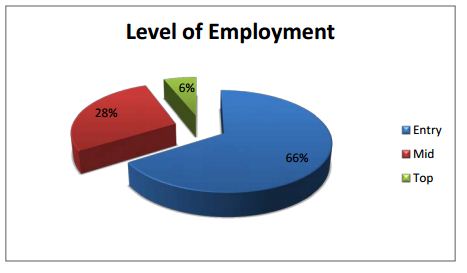
It is important to know which level is responding to my survey. It is more important to engage the employee in the entry level rather than in the high level as top level official are the most likely engaged and they are responsible to engaged employees by their act. After conducting a survey on 100 employees of Banglalink it is found that the largest respondent was entry level employees which are 66%, mid level employees are 28%. And only 6% respondent is Top level employees. As the number and top level employees are few and the access to get information from Top level official is lower so the number of Top level official respondent are few employees are Male among the survey group.
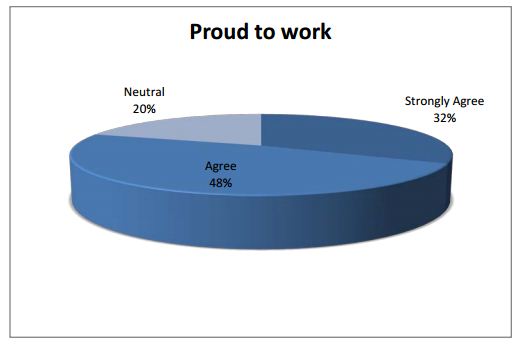
To find the level of involvement of employees in the job, it is important to know that Employees are really happy or proud or not to work in the organization. The first item on the survey measures an overall attitudinal outcome: satisfaction with one’s company. One could argue that in and of itself, it is difficult to act on the results of this item. Here we found almost a large portion of people are proud to work in the Banglalink. 48% and 32% employees of the
total survey group are respectively Agree and strongly agree with the statement that they are proud to work in the Banglalink. This indicated the level of happiness and satisfied of the employees. When the good number of employees are satisfied to work in their organization then there have a change to create an atmosphere to build employee engagement among the employees. Even 20% employees are neutral with the statement that they are proud to work in the Banglalink.
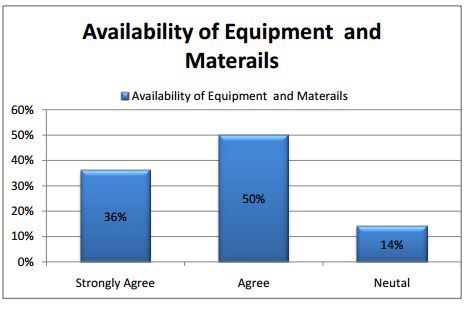
One of the important factors to involve employees in the job or work is the availability of necessary equipment and materials. Getting people what they need to do their work is important in maximizing efficiency, in demonstrating to employees that their work is valued, and in showing that the company is supporting them in what they are asked to do. Great managers keep this perception objective by helping employees see how their requests for materials and
equipment connect to important outcomes. After conducting survey it is found that
- 36% of the total respondent is strongly agreed that they have availability of Equipment and materials related to their job needs.
- Another 50% of the total respondents are agreeing with the statement that they have enough materials and equipment related to the jobs.
- Rest of the 14% of the total respondents is neutral with the statement that they have enough materials and equipment related to the jobs.

Organizational Support and benefits is very important factor to involve with their work. Employees need the organizational support to grow and learn so that organization needs support its employees by giving different financial and non-financial support to motivate employees so that they can more involve in the jobs and their day to day work so that there could build an distinctive brand of employees. After conducting survey it is found that
- 15% of the total respondent is strongly agreed that they have enough organizational support in different aspect of the life.
- Another 23% of the total respondents are agreeing with the statement that they have enough organizational support in different aspect of the life.
- A big portion which is 54% is neutral with the statement.
- 6% respondent is indicating that they are not happy with this statement. It means they think they do not have proper organizational support.
- Rest of the 2% of the total respondents is extremely dissatisfied with the statement that they have enough organizational support in different aspect of the life.
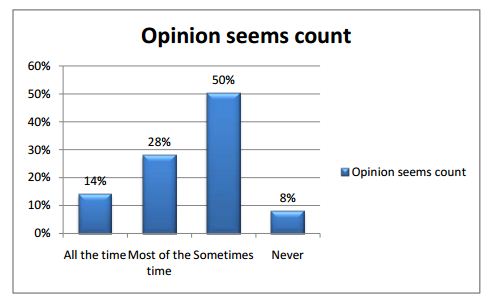
Asking for the employee’s input, and considering that input as decisions are made, can often lead to better decisions. This is because employees are often closer than the manager is to individuals and variables that affect the overall system. In addition, when employees feel they are involved in decisions, they take greater ownership of the outcomes. Manager or line manager are responsible to create an environment of employee engagement but counting the opinions of employees. After conducting survey it is found that
- 14% of the total respondent is believed that their opinion seems count all the time by their line manager or senior official at their office.
- Another 28% of the total respondents are believed that their opinion seems count most of the time by their line manager or senior official at their office.
- A big number of respondents which is 50% believed that their opinion seems count sometimes by their line manager or senior official at their office.
- Rest of the 8% of the total respondents is believed that their opinion does not seem count by their line manager or senior official at their office.
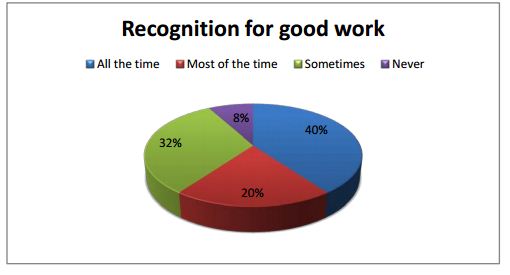
When managers ask employees who are performing at a high level whether they are suffering from too much recognition, they rarely, if ever, get affirmative responses. Another ongoing management challenge is to understand how each person prefers to be recognized, to make it objective and real by basing it on performance, and to do it frequently. After conducting survey it is found that
- 40% of the total respondent is believed that they get recognition for good work all the time by their line manager or senior official at their office.
- Another 20% of the total respondents are believed that they get recognition for good work most the time by their line manager or senior official at their office.
- A big number of respondents which is 32% believed that they get recognition for good work sometimes by their line manager or senior official at their office.
- Rest of the 8% of the total respondents is believed that they does not get recognition for good work by their line manager or senior official at their office.
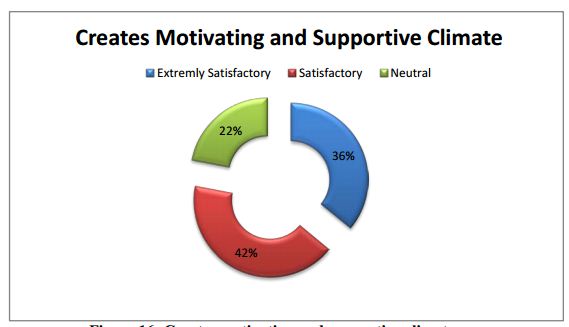
It is important to have motivating and supportive working environment in order to have engaged employment. If the environment is well fitted according to the expectation of the employee then there creates dissatisfaction among the employees which can creates disengagement among the employees. Creating motivating and supportive climate is one of the pre-requisite for ensuring employee engagement. Banglalink provides supportive working climate as here almost every employees help each other. Another important thing is that the surrounding is so friendly so that employees are working in the very relaxing mode. After conducting the survey I found.
- 36% of the total respondents are extremely happy with their existing environment and they believe that they have very motivating and supportive environment.
- 46% of the total respondents are satisfied with their existing environment and they believe that they have very motivating and supportive environment.
- Another 22% of the total respondents are neutral with their existing environment and they believe that they have motivating and supportive environment.

The very most important issue to create an engaged environment is ensuring equal treatment and justice. If there is proper justice and equal treatment employee becomes more motivate to work as they feel every employee is treated in a same manner. Moreover, Banglalink is very much careful about ensuring proper treatment and justice. There is no record of unequal justice at Banglalink. Moreover, every male and female employee is treated at a same manner. After conducting survey it is found that
- 18% of the total respondent is strongly agreed that they have equal justice and treatment regardless male and female employees.
- Another 30% of the total respondents are agreeing with the statement that they have equal justice and treatment regardless male and female employees.
- A big portion which is 30% is neutral with the statement.
- 20% respondent is indicating that they are not happy with this statement. It means they do not have equal justice and treatment regardless male and female employees.
- Rest of the 2% of the total respondents is extremely dissatisfied with the statement that they have equal justice and treatment regardless male and female employees.
Findings and Analysis of Correlations
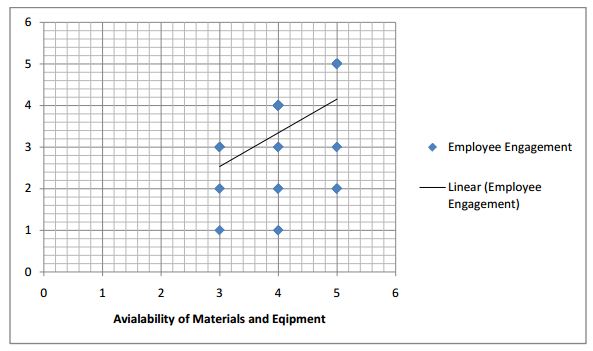
Interpretation: The Pearson Product-Moment Correlation Coefficient (r) or correlation coefficient for short is measures of the degree of linear relationship between two variables, usually labeled X and Y. X is independent and Y is dependent variable. Here, Dependent variable is Employee Engagement and Independent variable is Availability of materials and Equipment. While in regression the emphasis is on predicting one variable from the other, in correlation the emphasis is on the degree to which a linear model may describe the relationship between two variables.
Here is the correlation is R= 0.45 which means there is positive and quite strong correlation between the Employee engagement and Availability of Materials and Equipment. It means that if there is less availability of equipments and materials then the employee engagement will be lower and if there is proper availability of equipments and materials then employees will be more motivate to work.
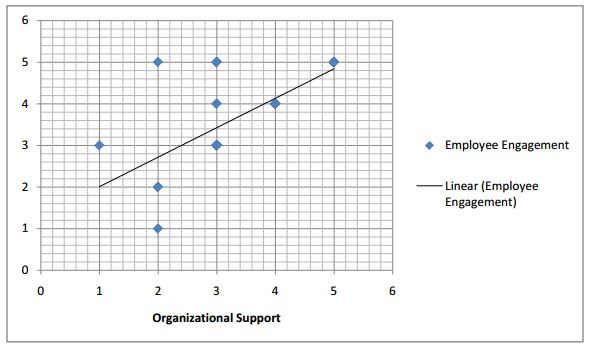
Interpretation:
From graph, it is seen that Dependent variable is Employee Engagement and Independent variable is Organizational Support. While in regression the emphasis is on predicting one variable from the other, in correlation the emphasis is on the degree to which a linear model may describe the relationship between two variables.
Here is the correlation is R= 0.69 which means there is positive and strong correlation between the Employee engagement and Organizational Support. It means that if there is less Organizational Support then the employee engagement will be lower and if there is Organizational Support then employees will be more motivate to work. Moreover the linear relationship between these two variable is very strong as the R=0.69 which is more than .50.

Interpretation:
From graph, it is seen that Dependent variable is Employee Engagement and Independent variable is Opinions Count. While in regression the emphasis is on predicting one variable from the other, in correlation the emphasis is on the degree to which a linear model may describe the relationship between two variables.
Here is the correlation is R= 0.50 which means there is positive and strong correlation between the Employee engagement and Opinions Count. It means that if there is absence of Opinions Count then the employee engagement will be lower and if there is Opinions Count then employees will be more motivate to work. Moreover the linear relationship between these two variable is very strong as the R=0.50 which is equal to .50.

Interpretation:
From graph, it is seen that Dependent variable is Employee Engagement and Independent variable is Provide Training and Development. While in regression the emphasis is on predicting one variable from the other, in correlation the emphasis is on the degree to which a linear model may describe the relationship between two variables.
Here is the correlation is R= 0.42 which means there is positive and not very strong correlation between the Employee engagement and Provide Training and Development. It means that if there is lack of Providing of Training and Development then the employee engagement will be lower and if there is proper Provide Training and Development then employees will be more motivate to work. Moreover the linear relationship between these two variable is not very strong as the R=0.42 which is less than .50.
Upshot of Employee Engagement:
Employee engagement is a route to business success. An engaged workplace encourages commitment, energy and productivity from all those involved to help improve production and business performance. Employee engagement is a workplace approach designed to ensure that employees are committed to business the organizations business values and goals. By making the employees involved in organization business, the HR manager will have to motivate them to contribute to the business and productivity success and at the same time it increase their sense of well being.
Employee engagement is the extent to which employees think, feel and act in ways that represent high levels of commitment to their organization. Engaged employees are motivated to contribute 100% of their knowledge, skills and abilities to help their organization succeed. Engaged employees care deeply about their company, want to contribute to its success and regularly have peek experiences at work.
Employee Job satisfaction is the terminology used to describe whether employees are happy and contended and fulfilling their desires and needs at work. Many measures purport that employee satisfaction is a factor in employee motivation, employee goal achievement and positive morale in the work place. Factors contributing to employee job satisfaction include treating employees with respect, providing regular employee recognition, empowering employees, offering above industry-average benefits and compensation, providing employee perks and company activities and positive management within a success framework of goals, measurements, and expectations.
Moreover, the positive result of Employee engagement is enhancing OCB which is ultimately effects on turnover rate. As I have found from the data analysis and research that employees are satisfied with their current position at the workplace and they have the positive mentality on the OCB which is directly influence the turnover rate of Banglalink. Previously the turnover rate was high but not it is lowering. So I can be sure that there is proper practice of Employee engagement at Banglalink which is visible at their revenue level, turnover rate and customer satisfaction.

Recommendation
This review suggests that employee engagement is a meaningful construct that is clearly worthy of future research.
- One area in need of investigation is the predictors of engagement. Evidence suggests that new employees score the highest on levels of engagement, which may in part be due to the optimism and enthusiasm they experience upon starting a new job. Further research is needed to determine exactly which attitudes they possess at this stage and what elements they are so highly engaged with in their work. Once these have been identified, managers can attempt to maintain that high level of engagement employees experience at the beginning of their employment throughout their entire period of employment by understanding clearly what predicts engagement for those individuals. Here is some of the recommendation for the HR operational activities and Employee engagement activities of Banglalink.
- From the observation of frequencies, it is found that more than 50% employees are responded that there is sometimes seems of opinion counts. For this instance the organization especially line manager can give the opportunity to speak out the opinions and take the opinions seriously so that employees or subordinate can be more motivate to work so that the employee engagement can be higher.
- It is very important to provide support to the employees from organization to learn and grow. From the findings, it has been seen than almost 50% employees from the total respondent are termed this statement as neutral it means they have doubts with this statement that there is proper organizational support to learn and grow. For this instance Banglalink can take steps to provide more support specially line manager can talk to the juniors and find what more types of facilities they need for engaged employment.
- In every organization, most of the employees have complain with their line manager, so in Banglalink. From data, a large number of employees have stated that sometimes they get encouragement from their line manager which is not good indication for Banglalink.
Conclusion
Employee Engagement is very important issue of the modern HRM. To survive in the competitive era of globalization an organization like Banglalink need to more focused on building engaged employment. From the survey it is found that Banglalink is maintaining a sound engaged employment. Moreover, HR Operations activities are very important for an organization to manage their employees in a disciplined way. As I have made this report on Banglalink’s HR Operations that is why I got the chance to know that how they manage their HR activities and how they implement those in their organization. I have focused on the HR Operations activity of Banglalink. Moreover, HR Operations is more responsible to create engaged employment as they are arranging different type of non financial benefits to the employees of Banglalink. On the other hand, by analyzing company policy and practices by questionnaire study it is now clear Banglalink is highly linked with creating engaged employment.
So at the end of this report it can be said that the HR Operations team of Banglalink is very much efficient in doing their job in a proper way. They follow all the effective ways to implement HR activity in their organization to manage all the HR issue including creating engaged employment.




![Report on Primary School Dropouts The Reasons Behind an Anthropological Investigation [part-2]](https://assignmentpoint.com/wp-content/uploads/2013/04/images-8-200x100.jpg)











